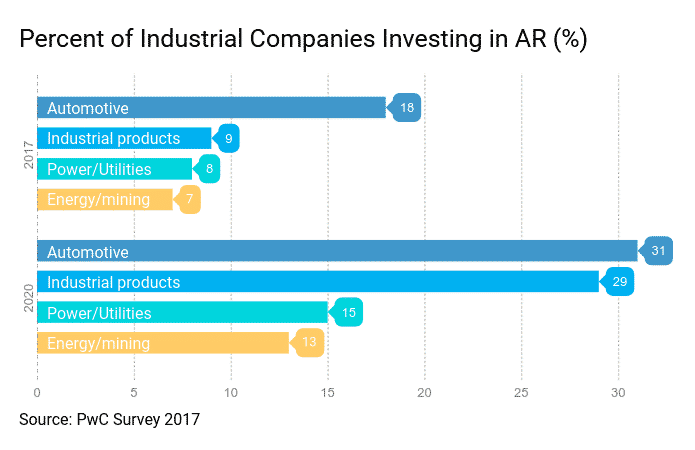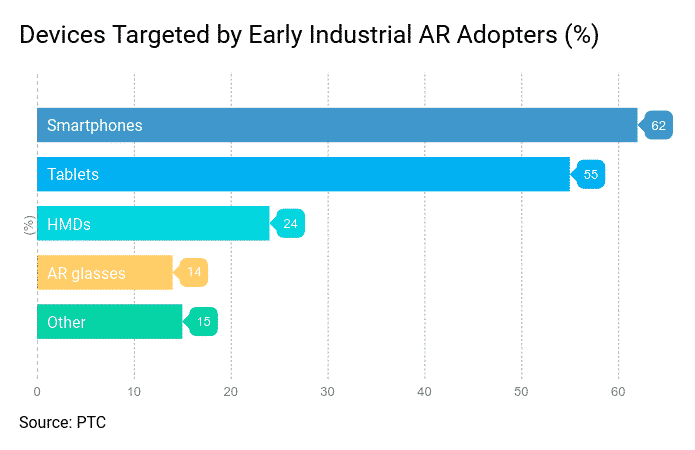Industrial Augmented Reality (AR) Boosts Equipment Maintenance, Field Service and Staff Training
Industrial Augmented Reality (AR) Boosts Equipment Maintenance, Field Service and Staff Training
- Last Updated: December 2, 2024
Softeq
- Last Updated: December 2, 2024



Why Industrial Companies Adopt Augmented Reality
By 2022, there will be 70 million active industrial AR users globally, and by 2020, most industrial companies will increase AR investments by almost 50 percent, according to PWC.

Image Credit: PwC
According to PTC, 86 percent of industrial enterprises plan to launch AR projects in the next 12 months to operate more efficiently, transfer knowledge across the enterprise more productively and bring their products to market faster.

Image Credit: PTC
There are two reasons why Augmented Reality is now getting considerable traction in the industrial sector:
- Manufacturing, automotive, oil and gas and utility companies have sufficient R&D budgets and are currently undergoing Digital Transformation.
- AR hardware has matured to the point where it can be used safely in industrial environments.
Industrial Applications of Augmented Reality
AR Remote Assistance Solutions for Equipment Maintenance and Field Service
The remote assistance concept is anything but new. In the IT industry, for instance, system administrators have long been using TeamViewer, Windows Remote Assistance and GoToMeeting to gain temporary view of a user’s monitor and solve issues with software performance and setup.
Compared to traditional remote assistance solutions, Augmented Reality extends support beyond desktop. The technology creates the so-called “see-what-I-see” experience, thus allowing remote experts to identify machinery malfunctions and visualize the data from equipment manuals.
According to Helen Davis, VP of Supply Chain at Coca-Cola, the company uses Augmented Reality glasses to communicate with equipment engineers and technicians from Germany, where their bottling equipment suppliers are based. The remote assistance solution reportedly helps Coca-Cola reduce travel costs and machinery downtime during changeovers.
Another example comes from Cisco. The company developed an industrial Augmented Reality data visualization solution based on Blippar AR Creation tool, which overlays the images of machine parts on top of physical equipment. The system allows Cisco technicians to install equipment 30 percent faster and boosts first-time accuracy by up to 90 percent.
The cost of maintaining industrial equipment typically comprises 30 percent of a company’s annual operational expenses. With AR, original equipment manufacturers (OEMs) can perform consulting, machinery audits, configuration and troubleshooting services remotely, and thus become more efficient.
On the subject of remote assistance, industrial companies resort to AR-based tools to continue the transformation of field service management (FSM), which initially began with the digitization of paper documents and uploading them to the cloud. The primary reason why OEMs adopt Augmented Reality is to empower technicians with real-time data while in the field and cut the number of follow-up visits (which currently make up 25 percent of all service calls).
A recent field study from XMReality, a company that focuses on Augmented Reality remote guidance, confirms AR-based solutions allow remote technicians to make 50 percent fewer errors and speed up problem-solving by 32 percent.
Augmented Reality’s potential stretches beyond creative industries, such as retail, entertainment and education. AR can help industrial companies become more efficient and better train their new employees.
Augmented Reality Solutions for Industrial Training
When it comes to getting to grips with physically large equipment situated in remote locations, AR empowers trainees to learn and create memorable associations. Learning through written language, videos or manuals proves to be less practical. With half of industrial plant employees due to retire in the next five years, fast and efficient staff education becomes critical — and here’s where Augmented Reality comes in handy.
The participants of the Mercedes-Benz training program use Microsoft HoloLens to study a vehicle’s internal parts components without dismantling it. A similar solution is used by Ford to project holograms of car designs on existing vehicles. The innovative approach changes the way prototypes are created and altered and fosters collaboration between design and engineering teams.
Other examples of applying AR in training outside the automotive industry feature Boeing and AGCO. Boeing’s technicians turn to immersive technologies to install electric wiring on an aircraft correctly. AGCO, an agricultural equipment manufacturing company, has been using Google Glass since 2014 to train employees to perform complex maintenance on immobile machinery. The solution helped the company reduce inspection time by 30 percent.
Tips to Maximize the Value of an Industrial AR System
Get Stakeholder Feedback
While Digital Transformation projects are initiated and administered by Chief Innovation Officers (CIOs), it's important that all stakeholders have a say in making the decision to invest in Augmented Reality app development: in most cases, workers know better than the C-Suite what's efficient and what isn't.
Collaborative decision-making, for instance, may regard the AR device form factor. According to AGCO, the company’s Google Glass initiative was driven by its employees following an unsuccessful trial of tablets, which were easily broken and expensive to replace. Through 2019, more industrial companies will adopt hands-free AR devices.

Image Credit: PTC
As of now, industrial companies are aiming towards device-agnostic immersive experiences, and make AR apps available on multiple gadgets. After Mobile World Congress 2019, the trend of smartphone-led Augmented Reality may finally shift to hands-free devices.
Ensure AR Solution Accessibility & Functional Stability
There are two things every company should bear in mind while putting industrial Augmented Reality to work: accessibility and stable performance.
- Accessibility refers to experts and technicians’ ability to operate an AR system intuitively and view information across different media.
- Stable performance means the system’s ability to support a large network of distributed devices used by remote technicians and the expert portal. In a nutshell, it’s all about sending the right information in response to a particular request and maintain the request-response pattern regardless of the server load.
One of the problems industrial companies encounter when designing an AR system is ensuring stable communication between an AR device and the application. The communication stability heavily depends on the cloud infrastructure, which enables technicians to send requests and assign them to particular experts.
For a mini-load system, a single-server solution where technician or customer requests are queued might be an option.
Challenges arise when the server receives too many requests (the DDoS attack scenario) or when the system incorporates multiple servers unaware of each other’s existences. As a result, the server either restarts itself or fails to forward a technician’s request to an expert.
That’s why industrial AR solutions' functional and nonfunctional requirements should be defined during the Proof of Concept (PoC) and Business Analysis stages. The points that require special attention include the system architecture, optimum technology stack, expected workload and target devices.
With 68 percent of industrial companies moving AR pilots into production within 12 months, it looks like 2019 will be a breakthrough year for immersive technologies. Does your company have AR projects in development? What technology- and human-related issues have you encountered so far? Share your story in the comments section below!
The Most Comprehensive IoT Newsletter for Enterprises
Showcasing the highest-quality content, resources, news, and insights from the world of the Internet of Things. Subscribe to remain informed and up-to-date.
New Podcast Episode

What is Hybrid Connectivity for IoT?
Related Articles





